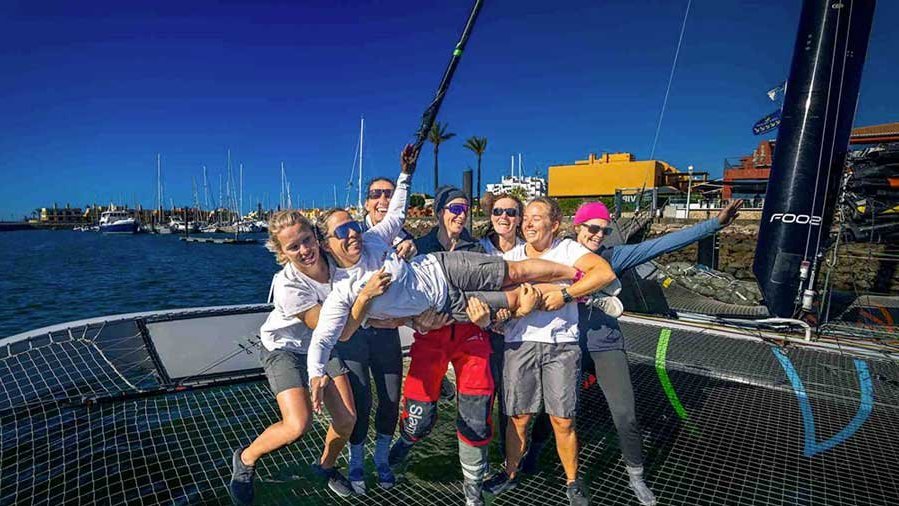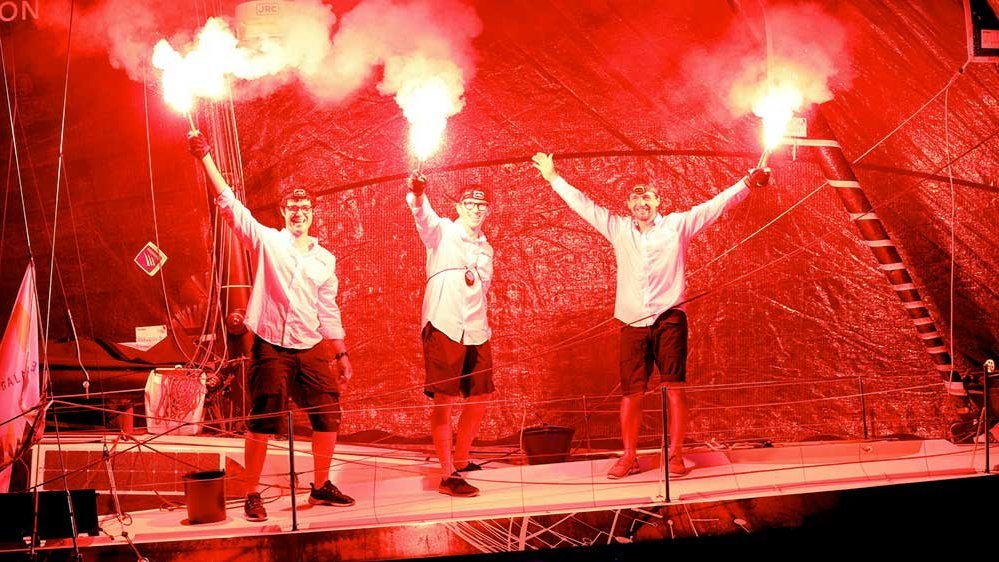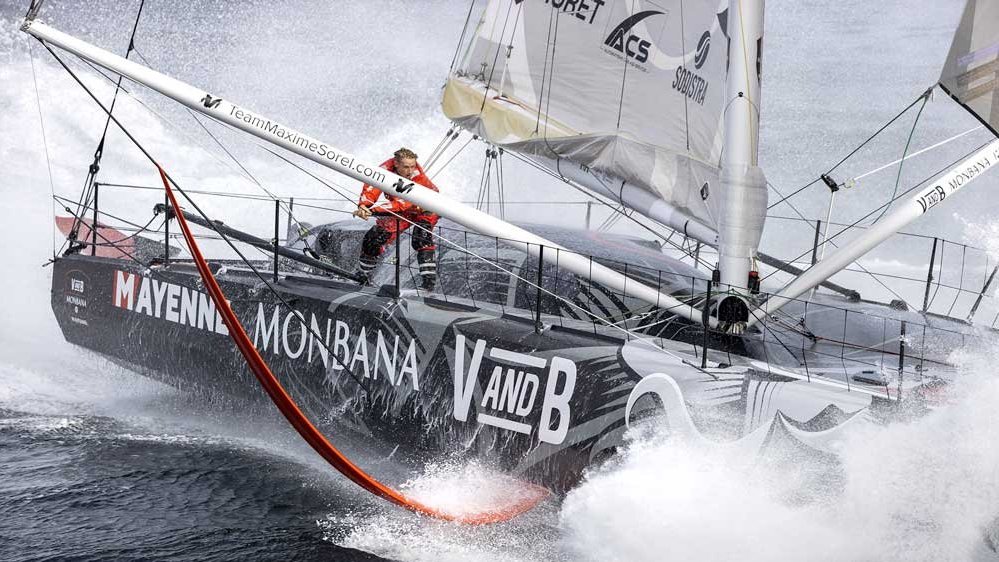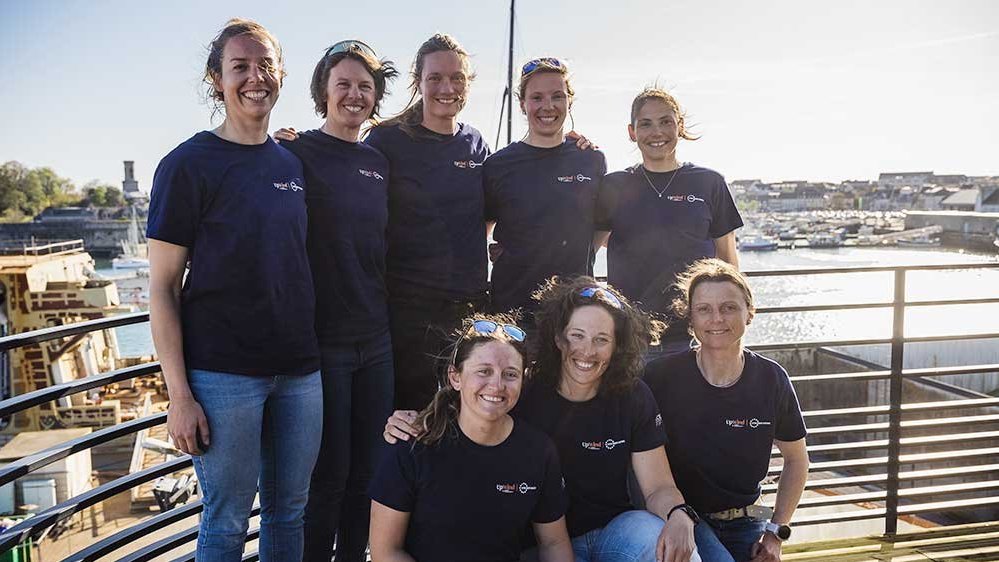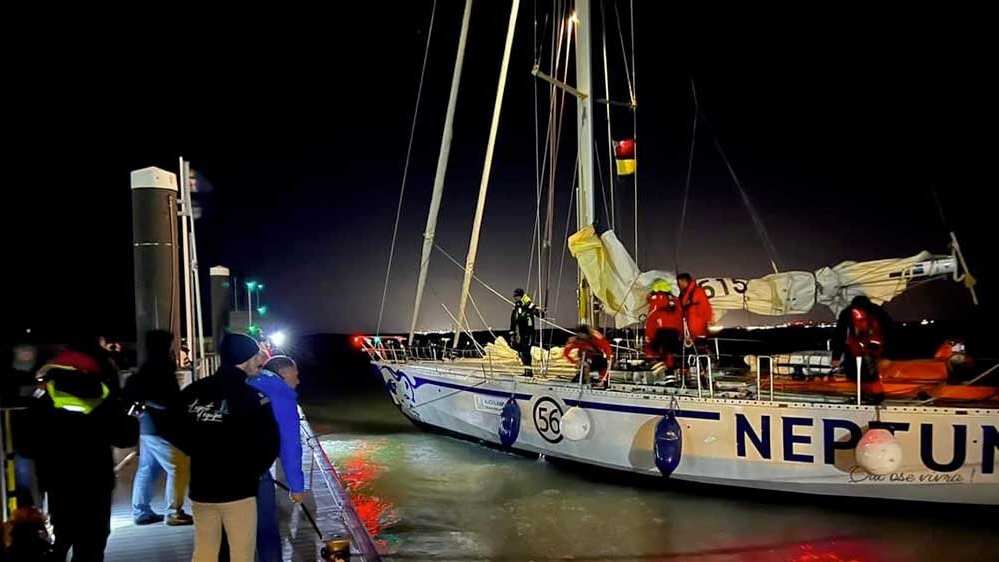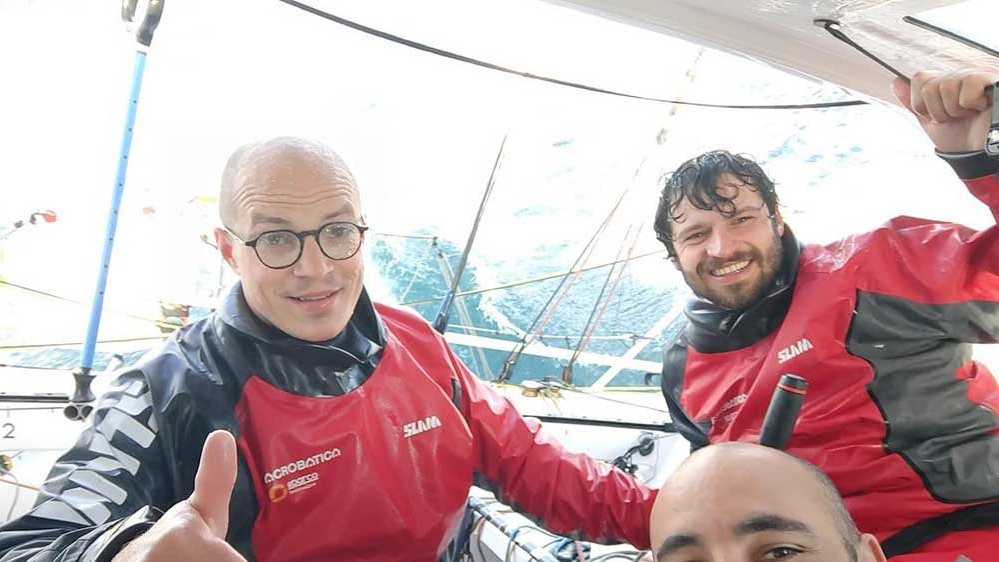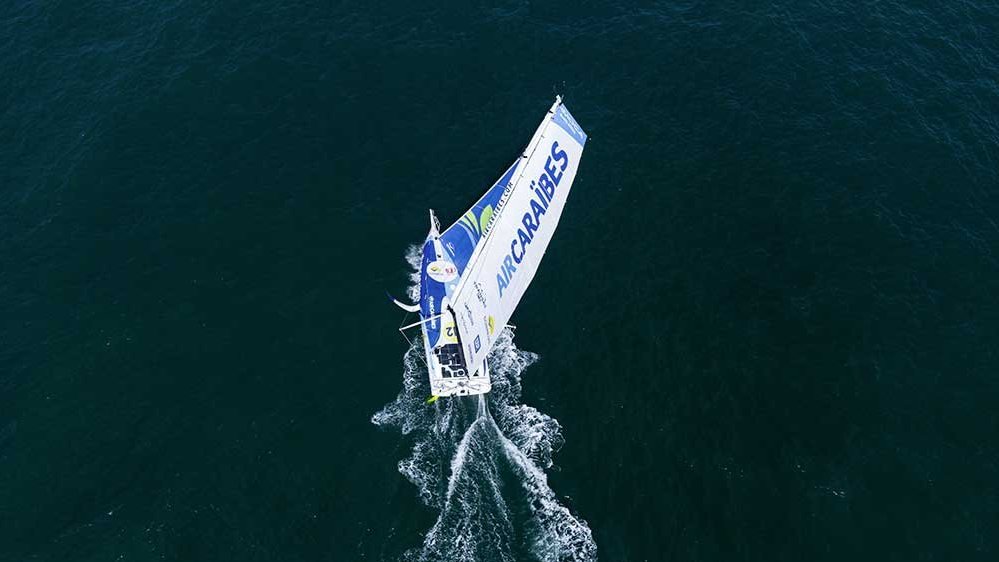
Imoca
Michel Desjoyeaux : "We’re finally going to be able to go sailing !"
The new VPLP / Verdier designed Open 60 launched in Port-La-Foret
mardi 21 septembre 2010 –
Toutes les versions de cet article : [English] [français]
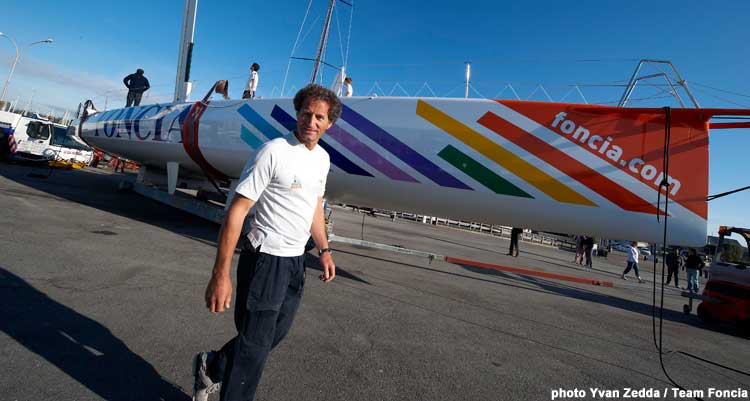
A new livery, new architects and a rugged outline. The latest Foncia doesn’t go unnoticed. In Port-La-Forêt, Brittany, on Monday, in front of some 200 people, she hit the water and successfully completed her 180° righting test. “We’re finally going to be able to go sailing !” said a delighted Michel Desjoyeaux, keen to discover how his 18.28 metre carbon craft performs under sail. This launch marks the end of a long and fascinating chapter and constitutes a sense of liberation for all those who have put so much effort into the creation of this racing machine. Since mid-July, the technical team have been working hard to keep everything on track. Ultimately she took just 15 days longer to build than planned. Indeed Foncia was built in the space of 6 months, which equates to two fewer months than the previous monohull aboard which Michel won the Vendée Globe. “In fact we had all the different elements on the go at the same time, design and construction, but that was the original challenge. We set the scene from the outset” explains Michel who, as per usual, has been involved in the entire process.
“Someone once said that the stage after ‘demanding’ was ‘a real drag’. Well, I think I’m still at the upper stage ! I’ve been involved in the whole thing, from the design through to tightening bolts in the yard. Of my 4 boats, I reckon I’ll know this one best. To know the boat inside out has always been my leitmotif : the more you know about how it’s made, the better you can use it, even more so when the discovery period in the marine Marine Marine nationale environment is short”.
Following on from Safran, Groupe Bel, PRB and Virbac-Paprec 3, FONCIA is the 5th monohull off the drawing boards of the VPLP design office and naval architect Guillaume Verdier. She differs from the others in various ways. The double lateral chine (whose upper chine is very pronounced) and soft m-shaped cross section deck make up the visible signature of the new FONCIA. These are just some of the features which are born from exploiting the latest constraints imposed by the Imoca Imoca #IMOCA class. These rules limit mast height to 29 metres and hence limit the sail area available for driving the craft, which in turn calls for a lighter boat. “The aim was to reduce the weight and bring down the centre of gravity. However we didn’t go all the way down that road as we didn’t want to compromise the boat’s reliability, explains Michel. We did have some leeway as regards the structure however. In fact the hull forms enabled us to make it more solid without being heavier. As such we made savings in other areas like the boom, which is 50% lighter than that on Foncia 1”.
The organisation Organisation #organisation of the deck layout is copied from the old monohull, with the exception that the cockpit is 70 cm narrower, resulting in reduced manoeuvring area and hence greater comfort and improved ergonomics. The way the ropes lead back across the boat has been further optimised with the headsail furler lines passing beneath the deck. Also under the heading of evolution is the big inward curve of the daggerboards which enables the boat to be slightly lifted, in the same way as foils, but without the disadvantages of heavily curved daggerboards. Finally and very importantly, the under hull rudders can be interchanged very quickly. The symmetrical system enables faulty rudders to be removed and changed over in 10 minutes. As far as safety is concerned, an escape hatch on the bottom of the boat (virtually invisible to the naked eye) and an additional watertight bulkhead have been added. Not exactly revolutionary, FONCIA is the result of a number of small evolutions, which now have to be tested at sea.
40 days to get the measure of the new steed before the Rhum
On 22nd October, Foncia will have to be tied to the dock in the port of Saint Malo. In the meantime, the skipper will need to size her up, get her measured, complete the stability tests and the 1,500 mile solo qualifier trip. However, this short timeframe doesn’t appear to frighten the skipper, who has been through this same process a few times now : “It’s worth pointing out that it’s roughly the same timeframe I had before the (victorious) Route du Rhum Route du Rhum #RouteDuRhum 2002 ! We’re not going to overlook anything as we’ve got ample time to do everything. We do have the experience of three other 60 foot monohulls to our credit after all and that will help us. If we don’t pull it off then it’s because we’re not good”. Right now Michel intends to work the boat up on the water with his team, a process which will include two training sessions at the end of September and early October in Port-La-Forêt. As such the Route du Rhum Route du Rhum #RouteDuRhum will serve as the first competitive run for both the boat and the skipper alike as it will be Michel’s first Route du Rhum aboard a monohull. He certainly won’t be in ‘discovery’ mode on this single-handed transatlantic race though : “I’ll be flat out and I see no reason why it should be any different” he warns.
Vincent Lauriot Prévost, VPLP design office
“The launch of a boat is an important and emotional stage. There’s always a sense of achievement and liberation for those who have put so much effort into designing and building it in record Record #sailingrecord time. It’s also the start of the boat’s second life : that of apprenticeship, development and performance. Michel has a short time to work her up but he also has the benefit of a fast learning curve. [...] Foncia is a boat which will look good. She’s a boat which will have some very special elements in her lines. You’ll recognise her. She’s different from the others, both in terms of her hull form and her deck form. She won’t be a clone.”
Guillaume Verdier, naval architect
“Race boats like this are a one-off, because they’re really made for the racer. There are an infinite number of solutions in architecture ; you mustn’t be restrictive. The various solutions stem from the fact that people sail differently and don’t have the same understanding or the same way of handling the boats. As regards the sail plans, the deck layouts and even the systems, all of it is very closely linked to the way in which these boats are sailed and the ability to sail them. Another of Michel’s strengths is knowing how to position the human cursor in this equation. He’s very good at that. [...] It’s been another successful collaboration with VPLP. In reality it was a tripartite system : VPLP, Michel’s team and myself. As such it’s three-way architecture, which is always more complicated but, at the same time, it is richer.”
![]() Info presse Team Foncia / www.teamfoncia.com
Info presse Team Foncia / www.teamfoncia.com
Dans la même rubrique
‘Westabout’ Solo Circumnavigation : Steve White to sail a VO70 solo around the world

Class40 : First Pogo 40S2 underwent a 180° inversion test
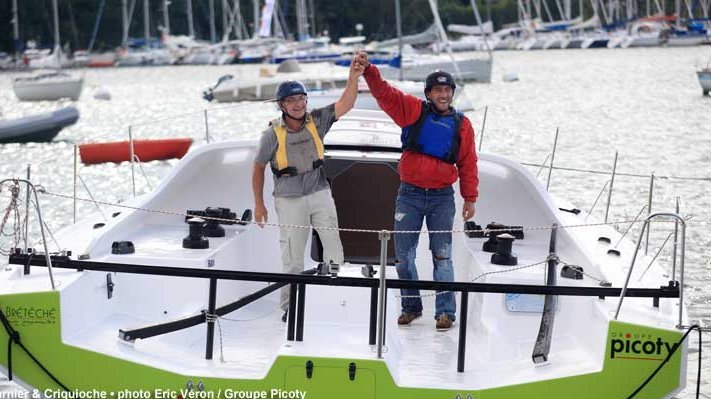
Barcelona World Race : Michel Desjoyeaux has chosen François Gabart
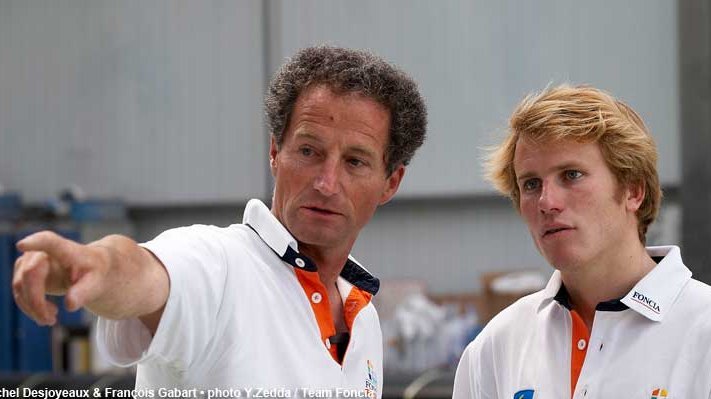
Normandy Channel Race : Ruyant - Leglatin take victory in the 1st NCR

 Sea, Sail & Surf news
Sea, Sail & Surf news